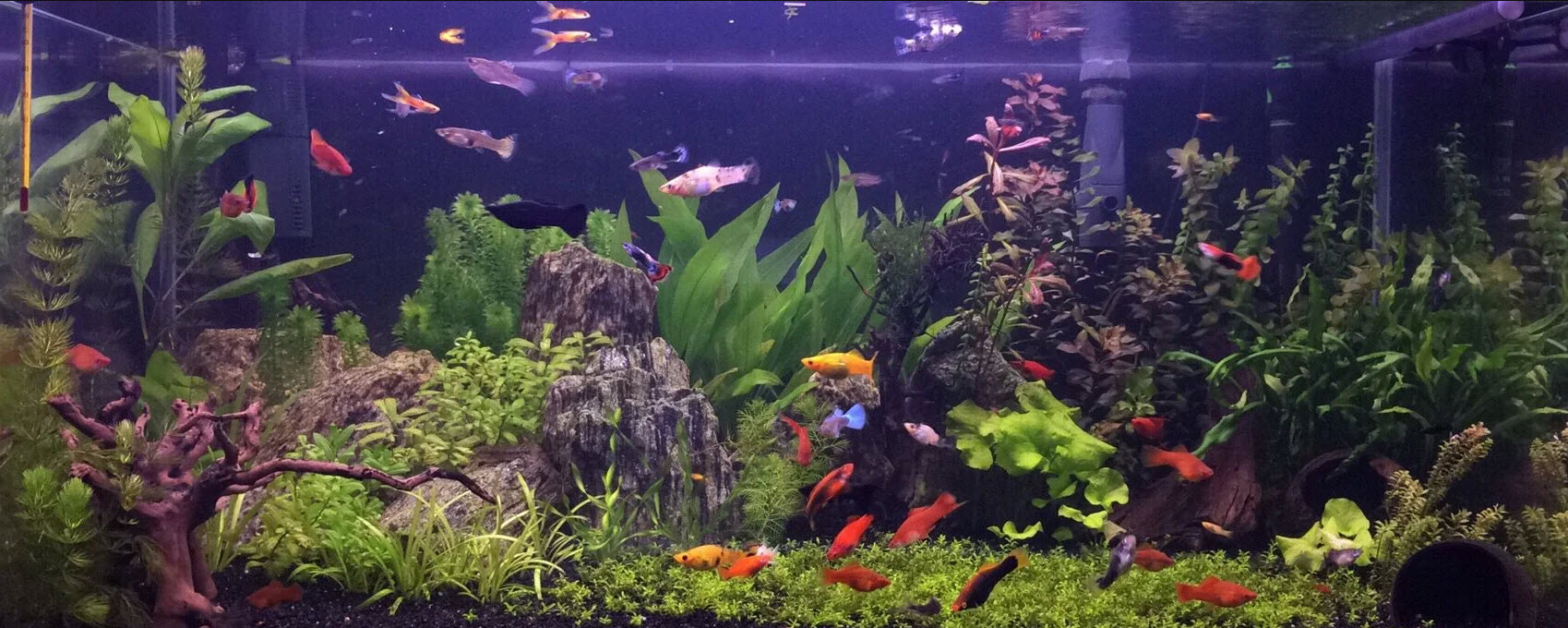
This is an article about what are called “livebearers”. These are fish which bear their young alive. This includes guppies, platies, mollies and swordtails. All livebearers have two common diseases:
- capillaria, an intestinal worm which typically manifests itself as hollow belly, arched back, wasting, spitting out food and intestines popping out.
- tetrahymena, a small skin parasite that typically either looks like ich or it appears as a white patch on the forehead of the fish.
And all livebearers do well in a very wide range of water, contrary to popular mythology. We look at guppies first and then we look at other livebearers.
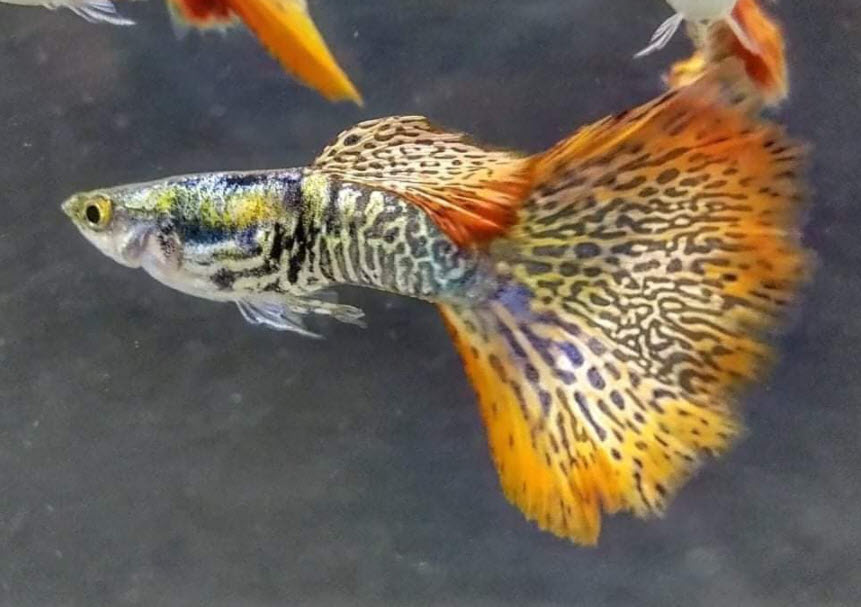
Guppies
Guppies are not a beginner fish anymore. It has to do with how they are bred. Guppies have been “line bred” for hundreds of generations, with brothers being mated to sisters. Fish species like guppies, with a very wide distribution in nature, which are then repeated crossed and then repeatedly line bred, tend to “break down” in their genetics. This genetic “break down” has made many guppy strains very weak, with very weak immune systems.
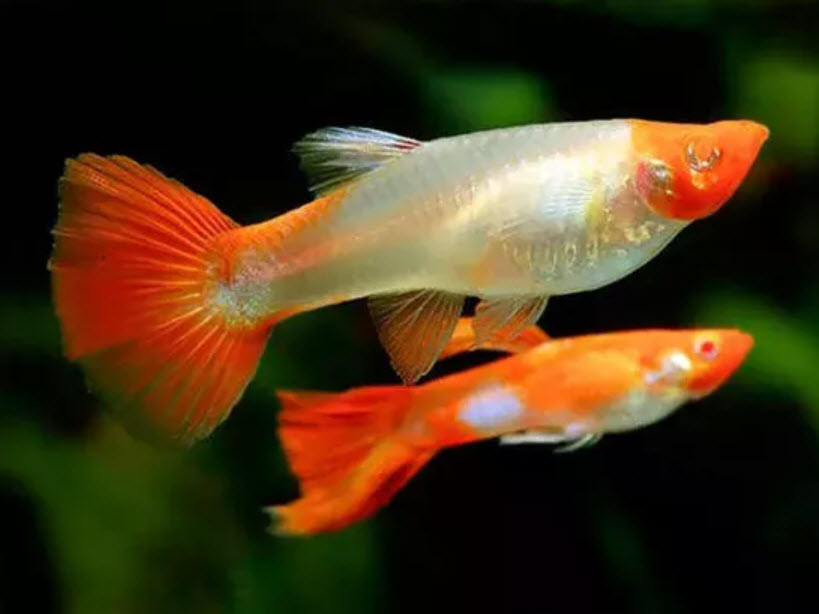
Guppies and Hard Water
There is a myth that guppies require very hard water with salt in it. This is not true. Guppies are not native to the hard alkaline waters (cenotes) found in the so called karst areas of carbonate rock such as is found in the Yucatan peninsula of Mexico. Rather guppies are found in both soft and hard waters in Northern South America, including the very soft acid waters of the small streams feeding the Orinoco River. Per Wikipedia:
“Guppies are native to Antigua and Barbuda, Barbados, Brazil, Guyana, Jamaica, the Netherlands Antilles, Trinidad and Tobago, the U.S. Virgin Islands, and Venezuela. Field studies reveal that guppies have colonized almost every freshwater body accessible to them in their natural ranges, especially in the streams located near the coastal fringes of mainland South America. Although not typically found there, guppies also have tolerance to brackish water and have colonized some brackish habitats. They tend to be more abundant in smaller streams and pools than in large, deep, or fast-flowing rivers”
Another myth is that guppies are schooling fish that need to be with other guppies in schools. Guppies do not school in the wild. If ten guppies are put in a 100 gallon aquarium they will NOT school but rather they will be found all over the aquarium. So it is perfectly acceptable to put a single guppy in an aquarium if one so desires.
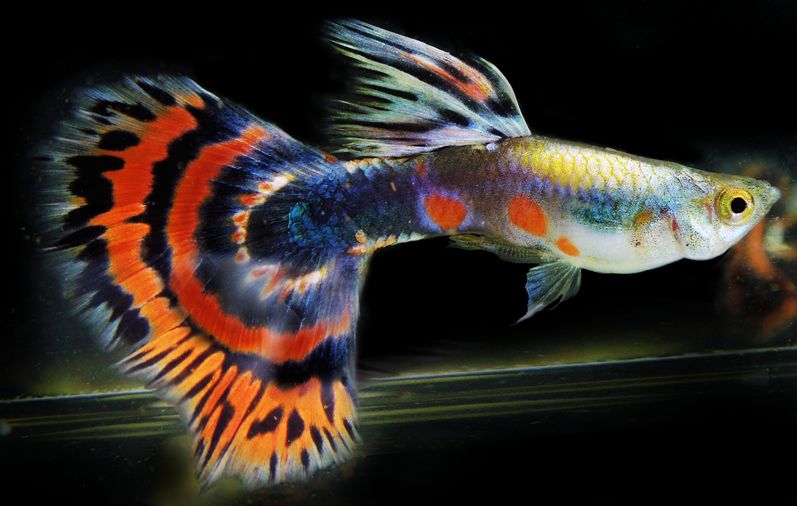
Guppy Diseases
When guppies arrive at your local fish store they have been kept under very good conditions if they are from a breeder or they have been constantly fed antibiotics if they are from southeast Asia. Because they have been flown in they typically are very stressed and very worn down (the pressure changes in an airplane are very hard on fish which have a swim bladder).
At the fish store they are exposed to many pathogens immediately. The three major pathogens are capillaria, tetrahymena and bacteria. These three pathogens are in most every tank in your local fish store (and your own tank!).
Capillaria are an intestinal worm. It hits livebearers and guppies very hard. Capillaria typically has the following symptoms: hollow belly, arched back, wasting, spitting out food and intestines popping out. But this can be due to other pathogens. The only way to know for sure that a guppy has capillaria is to do a microscope inspection of the feces. The feces will have distinctive barrel shaped capillaria worm eggs. Capillaria will kill guppies slowly, over the span of a few weeks. For more information on this disease go to this link:
10.12.2. Capillaria
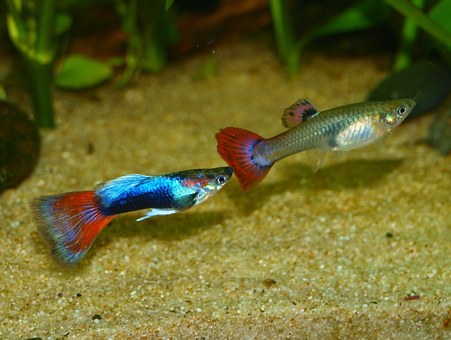
Guppies also get a disease called “tetrahymena” which can mimic ich but is a killer. Indeed, tetrahymena is known as the “guppy killer”. It is a small protozoan that loves water than is unclean, with a high organic content to it. So it thrives in tanks with little or poor biofiltration. It affects livebearers far more than any other fish. Platies, swordtails and mollies show symptoms of the disease before they die. Guppies typically show no symptoms and just die very rapidly. Often all the guppies will die in a week or less. For a more in depth article go to this link:
10.2.6. Tetrahymena
Bacteria that kill guppies are numerous. They are chiefly columnaris and aeromonas, but others take their toll. They typically move fast inside a guppy, sometimes killing them in mass overnight. These bacteria typically kill guppies internally with no outward sign.
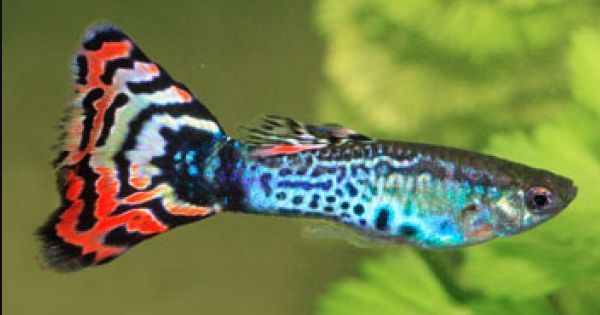
Male guppies are especially prone to this bacterial infection. They can’t easily get the immune system resources to their long tails. So bacteria can invade via the tails and kill the fish by internal organ failure quite rapidly. Many fish keepers, including the author and Diana Walstad, have been unable to keep male guppies alive longer than two weeks after they arrive from the store while the females do just fine. “In beauty lies death”.
Females who are very pregnant, with large bellies and dark “gravid spots”, are very prone to a bacterial infection called “columnaris”. This bacteria will infect all the babies as well as the mother. And 95% of the infected mothers and fry will die without treatment. I find some antibiotic food is always a good prophylactic treatment for gravid female guppies.
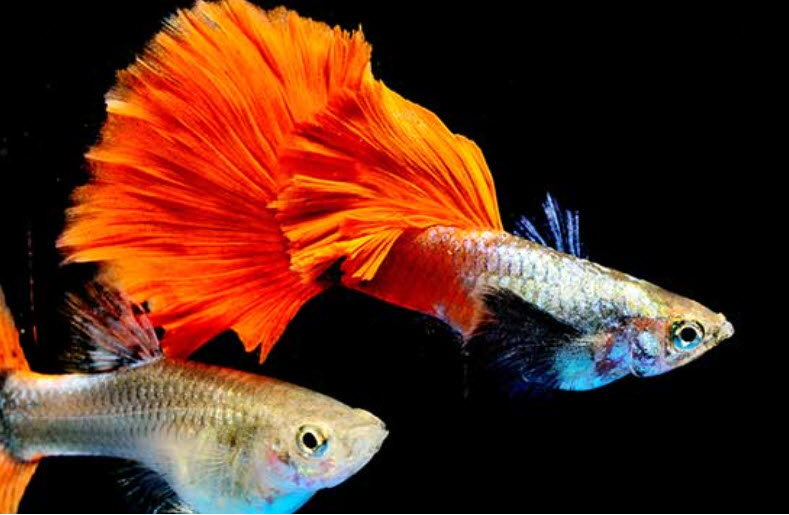
Prophylactic Drug Treatment
New guppies need to be prophylactically treated with medicated food as soon as they arrive at their new aquarium or hospital tank. Buy Thomas Labs Fish Bendazole (for capillaria worms) and Maracyn 2 (for bacterial infections) over the internet (there are many options listed below, this is just what the author uses). This treatment should also be used with guppies which are dying in an aquarium for nebulous causes.
It is easy to make medicated food. Heat 1/4 cup water (two ounces or 58 milliliters, not a lot) in the microwave. Then blend one seven grams of plain animal derived gelatin (Knox gelatin, one packet) into the hot water with vigorous stirring. Take two tablespoons of dry commercial fish food (pellets or flake) and mix it with just a little of the hot water/ gelatin mixture. Add hot water/gelatin until you get a paste like consistency. If it gets too watery just add more food.
Then add roughly 1/16 teaspoon (a 1% to 2% addition) of the two medications to the mud. Mix and mash the whole mass thoroughly. Spread it out into a pancake about 1/8th inch (3 mm) thick on a plastic film or a plate. Then put in the refrigerator. If you plan on keeping it for more than two weeks put it in a small plastic bag and freeze.
Feed it to your guppies twice in two days initially then once every three weeks for three months.
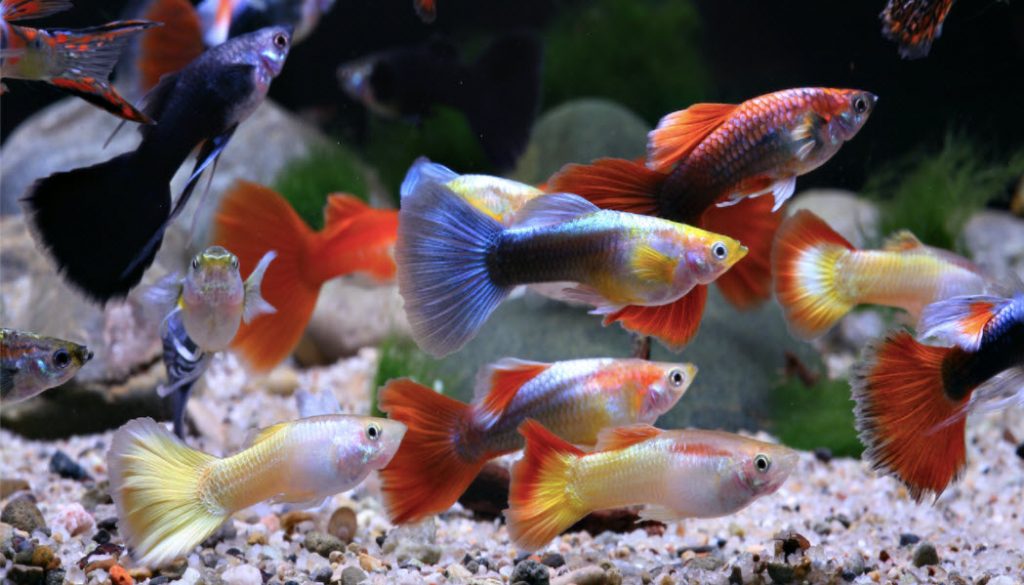
The treatment of guppies has some options:
- Capillaria can be treated with fenbendazole (Thomas Labs Fish Bendazole, Safeguard for dogs, and several livestock dewormers), Levamisole (Amazon, subaquaria .com and Valleyvet .com, Agrilabs Prohibit Soluble Drench Powder and DURVET Levamed Soluble Drench Powder Dewormer). Other medications supposedly effective against roundworms are Pyrantel Pamoate, Flubendazole (Kusuri Wormer Plus) and Piperazine.
- Bacterial disease can be treated with several broad spectrum antibiotics (Thomas Labs Fish Mox, Midland Vet Service Aqua-Mox, VetDepot Amoxicillin, Fishbiotic Ampicillin, Mardel Maracyn 2, Thomas Labs Fish Min, SeaChem KanaPlex, Thomas Labs Fish Doxy)
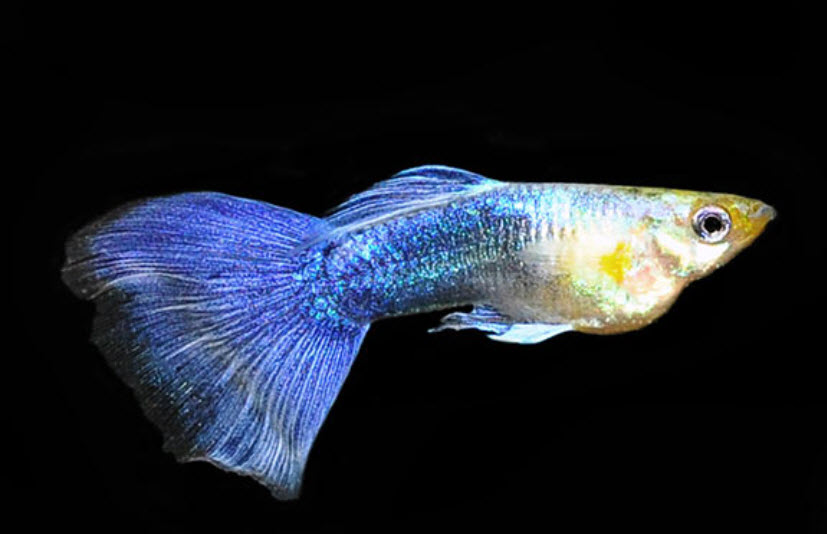
Water Quality and Guppies
Guppies have compromised immune systems. So one needs to keep the challenges to their immune system as low as possible. The main challenge for a guppy’s immune system is the bacteria in the water they swim in. The “bacterial count” of this water must be low. It must be very “clean” water. And by clean we do not mean water that is changed often. We mean water which is over-filtered and crystal clear.
Guppies should only be put into aquariums which are over-filtered, with at least a canister filter, a sump and/or an under-gravel filter. Hang on back filters don’t give adequate biofiltration for guppies. If you have only a hang on back filter get either a sponge filter or an under-gravel filter. Note that if under-gravel filters are cleaned regularly they don’t work and are a pain in the butt. But if they are just left alone for years at a time they are an excellent filter, especially if they have powerheads on the lift tubes.
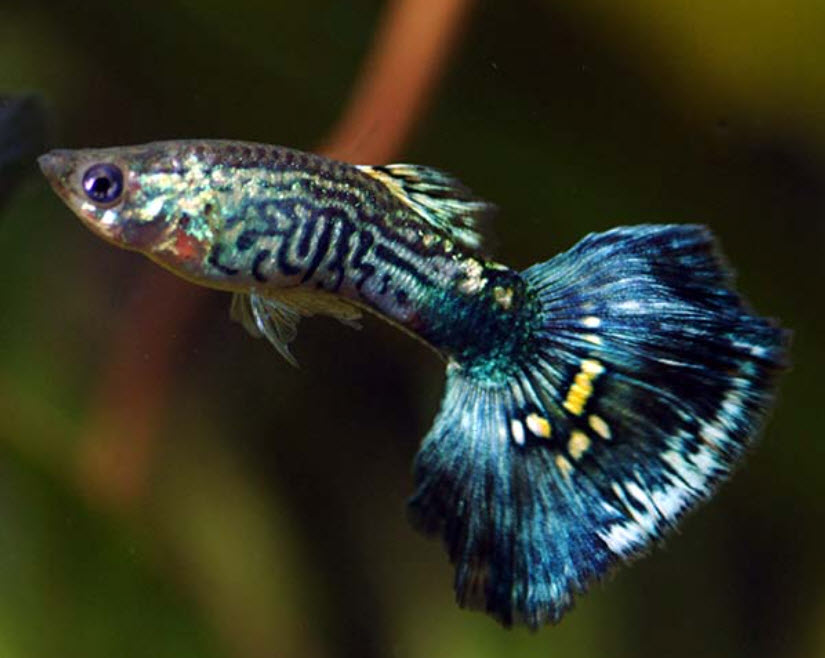
Guppies do much better in aquariums which have been established at least five months. The water should be very clear, with no cloudiness evident. An in-line UV unit is a great addition for a guppy aquarium.
It is important to note that bacteria count is logarithmic. “Dirty water” might be ten million bacteria per milliliter while “clean water” might be 10,000 bacteria per milliliter. Going from ten million to five million with a fifty percent water change is NOT going to do a lot for any fish. Contrary to popular mythology, water changes are NOT a panacea for any fish.
It must be emphasized that guppies are ONLY touchy with regards to the bacteria count. They do fine in a wide range of water hardness, pH and temperature. They are nowhere near as sensitive to ammonia, nitrite or nitrate as hobbyists seem to think.
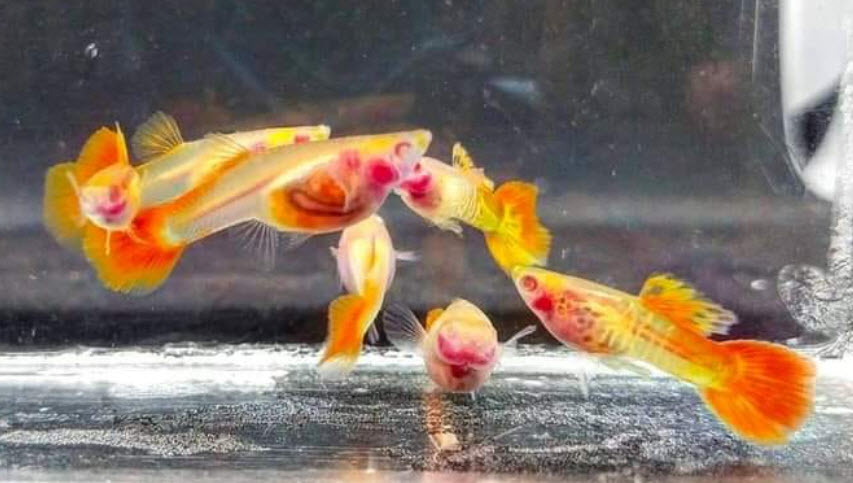
Endler Guppy
There is a type of guppy called an “Endler livebearer” which is basically a subspecies of guppy (Poecilia wingei) which has not had all the selective cross breeding of the standard guppy done to it. There are constant “tempest in a teapot” conversations on whether or not this is a separate species from a guppy. I can only say “Who cares?”
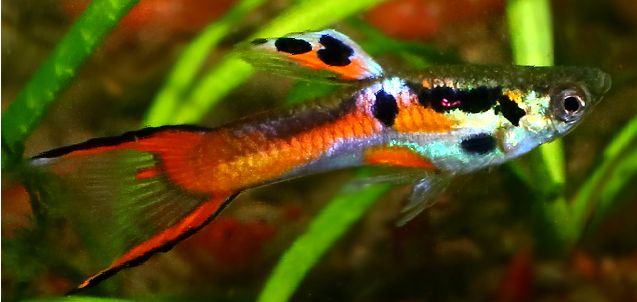
Because the Endler has not had all the selection done on it it is a much hardier fish than the line-bred guppy. The colors are absolutely astounding.
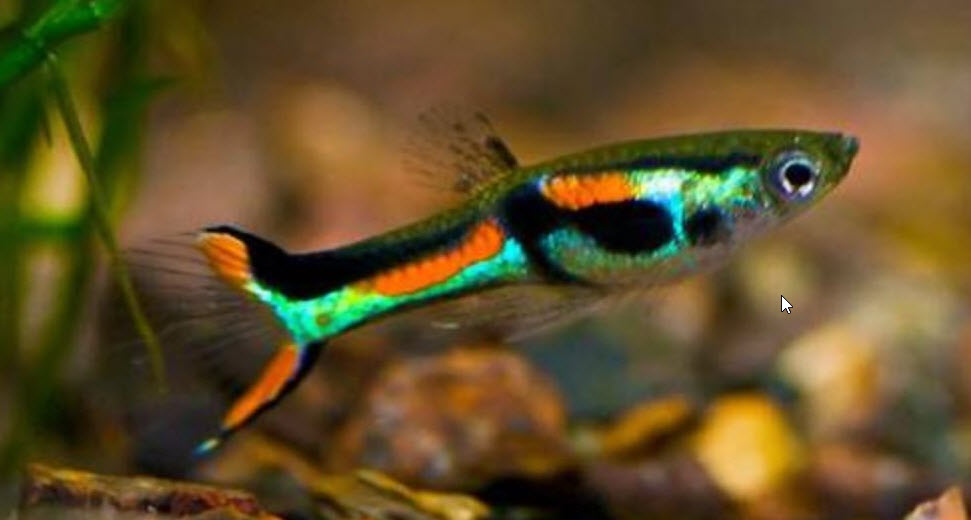
I had one tank filled with literally hundreds of male Endler guppies from several different lines which I bred in a large planted tank in the back room (five females for every male). Up close it was fascinating. From several feet away it was just kind of confusing.
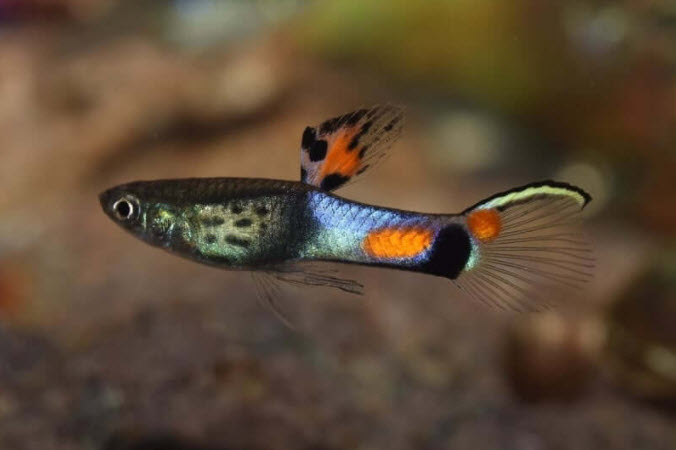
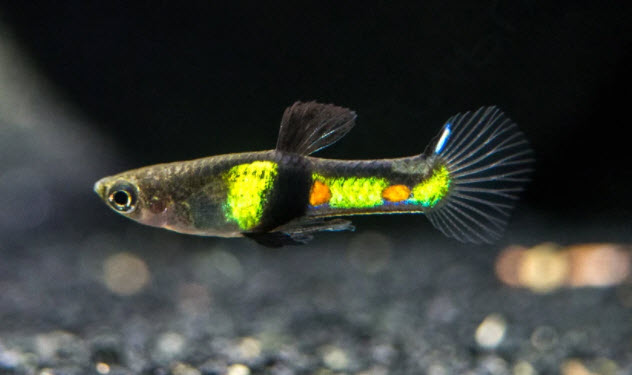
Mollies
Mollies are also livebearers. Mollies, like guppies, are highly inbred and share a few of the problems of inbred guppies. Mollies should get the same prophylactic drug treatment for capillaria and bacterial disease upon receipt.
Mollies are especially prone to the shimmies because of genetics. Mollies have been bred from many distinct species. Then they have been repeatedly line bred, with brothers being mated to sisters. As a result Mollies tend to “break down” in their genetics. So mollies are very genetically prone to the “shimmies”. The other livebearers, platies and swordtails, are all descended from a single species which a relatively small distribution. So they don’t “break down” when line bred.
The male molly shimmies in the courtship display. In mollies which have been line bred too much this seems to be amplified to the point where the fish can no longer control themselves. There is little one can do for such genetically flawed fish.
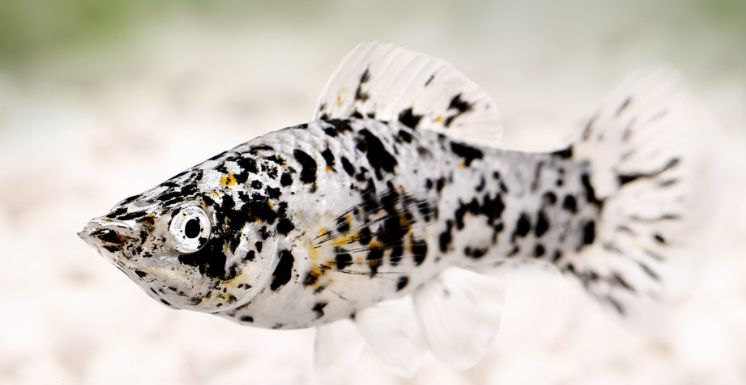
Balloon Mollies and Platies
There are line bred types of mollies and platies that are called “balloon”. These fish have genetically shortened spines. These fish have compressed internal organs and as such are very prone to bloat and swim bladder disease. They need better care than most livebearers and are not what I would call a “beginner fish”.
Platies and Swordtails
Platies and swordtails are the two easiest livebearers to keep. They do well in almost all water conditions and breed like rabbits. Luckily they also rapidly eat all their young unless the tank has a heavy cover of fine leaved plants where the young can survive. And note that swordtails can be somewhat aggressive.
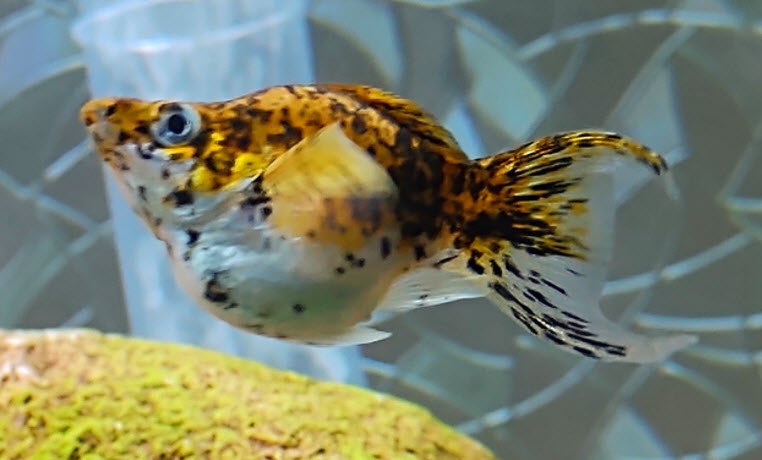
All Livebearer Fish Cautions
All livebearers seem to be prone to get two diseases more than other fish do. If one has only platies, swordtails and mollies dying in a community tank with no visible symptoms then one should treat for capillaria (see above for treatment options). If the platies, swordtails and mollies die with white spots or a white patch on the head, suspect tetrahymena.
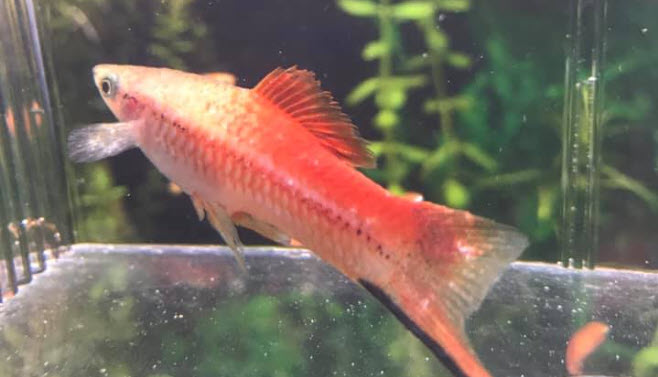
Tetrahymena also can look much like ich. For a more in depth article go to this link:
10.2.6. Tetrahymena
Breeding Livebearer Fish
Breeding livebearer fish, eggs and fry do “best” with the following:
- Bacteria free, crystal clear, over filtered water
- Great aeration with either “choppy waves” at the water surface or a big air pump and air stone.
- A food with at least 40% protein and 10% fat in it
- Calcium both in the water as a GH over 6 and in the food as fish meal (includes bones)
These are for “optimum” breeding of virtually ALL tropical fish. None of these points is “necessary” in any sense of the word. Livebearers tend to be very fecund even in bad water and with poor food, breeding like rabbits. Note that all livebearers eat their young as soon as they exit the females. If one wants the livebearer babies to survive put a lot of fine textured plants in the aquarium where the young can hide.
If you are so inclined, you can add plaster of Paris or Tums (calcium carbonate) to increase GH. Read the label of the food you feed to see the protein and fat levels. And hunt for either “fish meal” or “whole fish” as one or preferably two of the first three ingredients in the food in order to provide calcium in the food. But again, don’t worry about it. If you ignore the list above you will probably still have far more babies than you can handle.
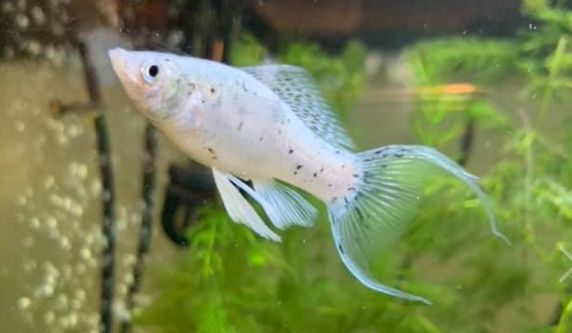
Salt in the Water
There is a whole host of anecdotal stories that all livebearers, including guppies, mollies, platies, and swordtails, do best with more salts and hardness in their water than most fish. This is simply not supported by the science.
There are many hybrid varieties of several different Poecilia species (including P. latipinna, P. mexicana, P. sphenops, and P. velifera) that are collectively known as “mollies”.
A paper was done on native Yucatan molly, Poecilia velifera (“The effects of water type on growth, survival and condition of Poecilia velifera”, Semra Küçük, 2010). This compared the growth rate of this livebearer in hard water (14 GH, 19 KH) versus soft water (1 GH, 4 KH). There was no difference in growth rate or mortality in the two groups. The Yucatan molly lives in brackish coastal waters of the Yucatan peninsula and if any livebearer were to require salty hard water it would be this molly.
Native Water Conditions for Platies, Mollies and Swordtails
While all adult fish are actually quite accepting of a very wide range of water parameters, it is true that fish tend to do their best in waters which duplicate the native waters they are found in. So one needs to look at the native waters of livebearers to determine the water conditions which are “optimum”.
The native waters of most of the livebearers in the trade are NOT regions with high water hardness and pH. For instance, the common molly (poecilia sphenops hybrid) supposedly is native to brackish waters per every “expert”. Per the IUCN this is the native range of the sphenops molly:
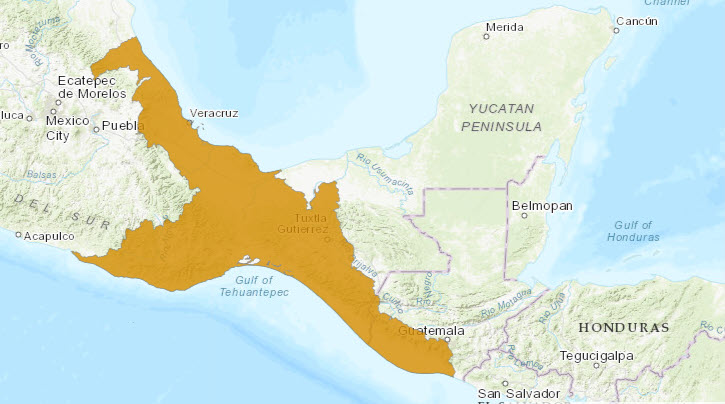
This is an area of largely igneous rock which will give rivers and streams with 6.5 to 8.0 pH and 5 to 10 GH and 5 to 10 KH with a low salt content. This is NOT an area with a lot of limestone which will give hard water.
The sailfin molly, P. latipinna, does NOT require salt in the water. It is found in soft waters from the Carolinas to Louisiana. This fish is seen in the aquarium trade.
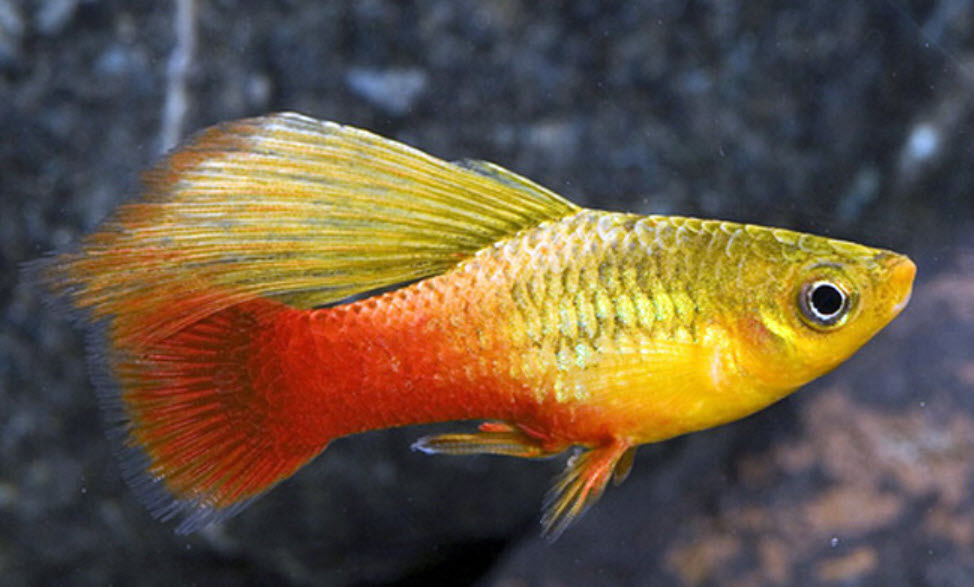
The swordtail’s (Xiphophorus) native waters are also not known for having any hardness or saltiness. This is the range of the swordtail in the wild:
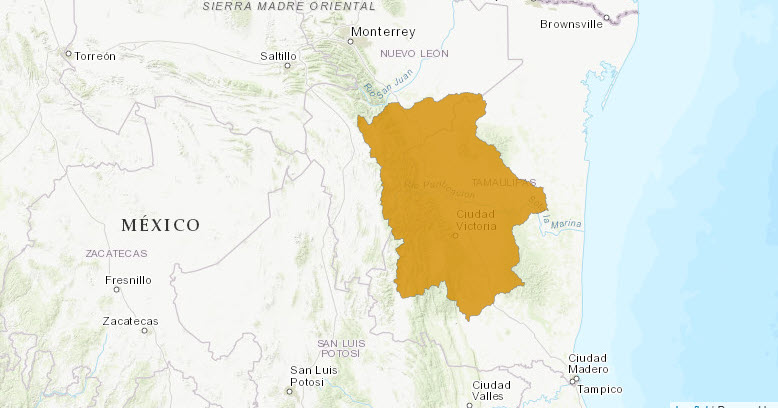
Again, this area has very little in the way of limestone and very little in the way of hard and/or salty water.
Like most fish livebearers will not do well in water with total dissolved solids less than 50 (i.e. RO water or very soft tap water). But there is no objective science the author could find which says they need more than 50 TDS or that they need high pH, KH or GH water.
Then the idea that fish are raised in hard salty water so they need hard salty water is also a big myth. Go to the following link to see why that simply isn’t true:
4.7. Breeding Doesn’t Change Water Tolerance
The author feels bacterial count is much more important for livebearers than pH, salts or hardness. But adding some salt and some hardness won’t hurt the livebearers. So if one believes the stories, have at it.
The best way to give a harmless placebo to keepers of livebearers is to simply add a bag of crushed coral or aragonite to the filter. This will buffer the water to a level which livebearers supposedly like. Again, there is no science which supports this addition and clean water is much more important. But some people like to do things “just in case”.
.
Return to Fish Selection Menu
.
Aquarium Science Website
The chapters shown below or on the right side in maroon lead to close to 400 articles on all aspects of keeping a freshwater aquarium. These articles have NO links to profit making sites and are thus unbiased in their recommendations, unlike all the for-profit sites you will find with Google. Bookmark and browse!
.

Harry Teet says
Hello, I have come across information about “EUSTRONGYLIDES SPECIES” of Nematodes from this source: https://edis.ifas.ufl.edu/publication/FA091
I was wondering if this could apply as an addition to this article? I am not sure how relevant they are to aquarium hobbyists indoor fish. Although people sometimes use outdoor water in their tanks, which would introduce the problem to a tank.
Dave says
In reply to Kristine …… Pregnancy can cause death, as can several hundred other things. You will never know for sure which one killed her.
Kristine says
I tried googling this, but apparently most people DON’T do autopsies on their dead fish and look at tissue under a microscope.
Granted, I don’t have any idea what I’m doing beyond looking for anything obviously wrong, like something moving, or something that just looks strange.
I have my male and females in separate tanks as of a month ago.
Yellow and another fish (with pop eye) went into a hospital tank a week ago.
neither was interested in eating their delicious food laced with maracyn 2, fenbendazole, and erythromycin (I like to be thorough). Also added a smidge of malachite green (I forgot the brand name) and maracyn 2 (bc I like throwing money away) to the water.
pop eye on the other fish went away, yellow still seemed off, but the other dozen females in her tank were fine. so I figured it wasn’t contagious and put em back in. started feeding the entire tank medicated food.
Fast forward – Yellow died today. she was at the top of the tank (minor pinecone) resting in some floating plants gasping at air. later, she was sideways.
10 gallon mature tank – undergravel filter air powered, UV filter in tank, and a canister. three amanos and half a dozen stripey caridinias as an assistant cleaning crew.
made sure she was dead, then decapped just to be on the safe side.
then I cut her open. nothing moving or obviously alive on her scales, gills, and intestines. nothing weird colored or strange looking.
her eggs though. she had a ton of em, I bought her as a baby about ten months ago, and she never had a large dark gravid spot. more of a large translucent spot.
her eggs were entirely empty except for one which had an almost fully developed baby in it.
is it possible that pregnancy was the cause of death rather than a microbiological factor?
Dave says
In reply to anonymous ….. Way back when I kept livebearers I didn’t follow any ratio “rule” and never had a problem. But some feel one should spread out the aggression of the males by using a four female to one male ratio.
Anonymous says
Does the ratio of males to females really matter for livebearers?
Dave says
In reply to Steve ….. Guppies just don’t amount of much of a bioload despite the high numbers, so I would say go for a Walstad tank. I’m not a big fan of Father Fish since the water always goes yellow.
Steve says
I have been really enjoying all of your knowledge & writing on this site. On to my question(s). . .
I have kept guppies & goldfish for years (separately, mind you). From late Spring until early Fall the guppies are outdoors in my small water feature (50 gallons or so) and the goldfish are indoors. From early Fall until late Spring the goldfish are outside and the guppies transition to my two indoor tanks (previously a 29 gallon & a 46, but now I’m swapping out the 29 gallon and setting up a 50 gallon).
Right, so I’ve just moved all the guppies indoors a few days ago, and *now* I’ve stumbled upon this whole Walstad/ Father Fish / Planted Aquarium concept. . . but as I’m reading what you’ve mentioned in this chapter I’m unsure that guppies (especially in the density that I keep them — I easily have over 100 fish in this room with me right now) are well-suited to the planted aquarium w/ soil & sand & what-not.
What are your thoughts on this? I appreciate your time.
Dave says
In reply to anonymous …. There is simply now way to know about the hardiness of ANY guppy hybrids. It is pure chance. But a hybrid with a endler will be about 50% less likely to inherit a bad gene.
Anonymous says
Are the hybrids between endler livebearers and guppies still hardy?